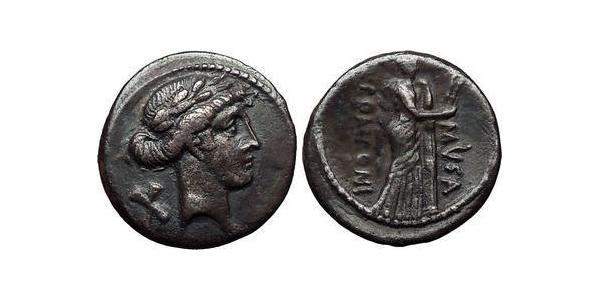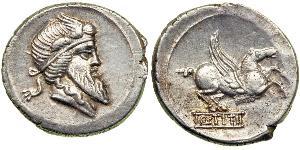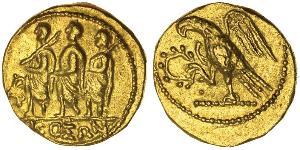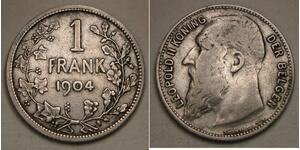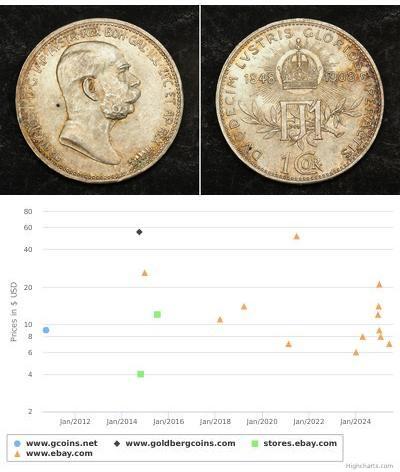[ 4475] Q. Pomponius Musa moneyer, EUTERPE - MUSE of LYRIC POETRY, Silver Denarius (19mm, 3.50 gm.) Rome, 66 B.C. Reference: Babelon Pomponia 13. Sydenham 815. Crawford 410/5. Laureate head of Apollo right, behund two flutes in saltire. Q.POMPONI-MVSA Eutherpes standign right, resting left, elbow on column and holding two flutes in right hand. Provided with certificate of authenticity. CERTIFIED AUTHENTIC by Sergey Nechayev, PhD - Numismatic Expert In Greek mythology, Euterpe (/juːˈtɜrpiː/; Greek: Eὐτέρπη [efˈterpi] Ancient Greek: [eu̯térpɛː]; "rejoicing well" or "delight" from Ancient Greek εὖ 'well' + τέρπειν terpein 'to please') was one of the Muses, the daughters of Mnemosyne, fathered byZeus. Called the "Giver of delight", when later poets assigned roles to each of the Muses, she was the muse of music. In late Classical times she was named muse of lyric poetry[1] and depicted holding a flute. A few say she invented the aulosor double-flute, though most mythographers credit Marsyas with its invention. Late mythographers, such as the author of the Bibliotheca and Servius, describe the Thracian king Rhesus, who appears in the Iliad, as son of Euterpe and the river-god Strymon; Homer calls him son of Eioneus. The Roman Republic was the phase of the ancient Roman civilization characterized by a republican form of government. It began with the overthrow of the Roman monarchy, c. 509 BC, and lasted over 450 years until its subversion, through a series of civil wars, into the Principate form of government and the Imperial period. The Roman Republic was governed by a complex constitution, which centered on the principles of a separation of powers and checks and balances. The evolution of the constitution was heavily influenced by the struggle between the aristocracy, or the patricians, and other talented Romans who were not from famous families, the plebeians. Early in its history, the republic was controlled by an aristocracy of individuals who could trace their ancestry back to the early history of the kingdom. Over time, the laws that allowed these individuals to dominate the government were repealed, and the result was the emergence of a new aristocracy which depended on the structure of society, rather than the law, to maintain its dominance. During the first two centuries, the Republic saw its territory expand from central Italy to the entire Mediterranean world. In the next century, Rome grew to dominate North Africa, the Iberian Peninsula, Greece, and what is now southern France. During the last two centuries of the Roman Republic, it grew to dominate the rest of modern France, as well as much of the east. At this point, the republican political machinery was replaced with imperialism. The precise event which signaled the end of the Roman Republic and the transition into the Roman Empire is a matter of interpretation. Towards the end of the period a selection of Roman leaders came to so dominate the political arena that they exceeded the limitations of the Republic as a matter of course. Historians have variously proposed the appointment of Julius Caesar as perpetual dictator in 44 BC, the defeat of Mark Antony at the Battle of Actium in 31 BC, and the Roman Senate's grant of extraordinary powers to Octavian (Augustus) under the first settlement in 27 BC, as candidates for the defining pivotal event ending the Republic. Many of Rome's legal and legislative structures can still be observed throughout Europe and the rest of the world by modern states and organisations. The Romans' Latin language has influenced grammar and vocabulary across Europe and the world. Payment & Shipping: Will accept payments via PayPal. = MM_contentVersion;
}
else if (navigator.userAgent && navigator.userAgent.indexOf("MSIE")>=0 && (navigator.appVersion.indexOf("Win") != -1)) {
document.write('\n');
document.write('on error resume next\n');
document.write('MM_FlashCanPlay = ( IsObject(Cr ...
читати далі

|
Добавив:
anonymous 2015-08-18 |
Similar Coin Groups
2025-05-27
- Нова монета додана до 1 Франк Бельгія Срібло Леопольд II (1835 - 1909)
1 Франк Бельгія Срібло Леопольд II (1835 - 1909)
в групі 15 монет / 14 цін
⇑
BELGIUM 1 Franc 1904 - Silver 0.835 - Flemish Text - Leopold II. - VF+ - 4176 *
2025-05-23
- Історичні ціни на монету
Можливо, Вас зацікавить...

